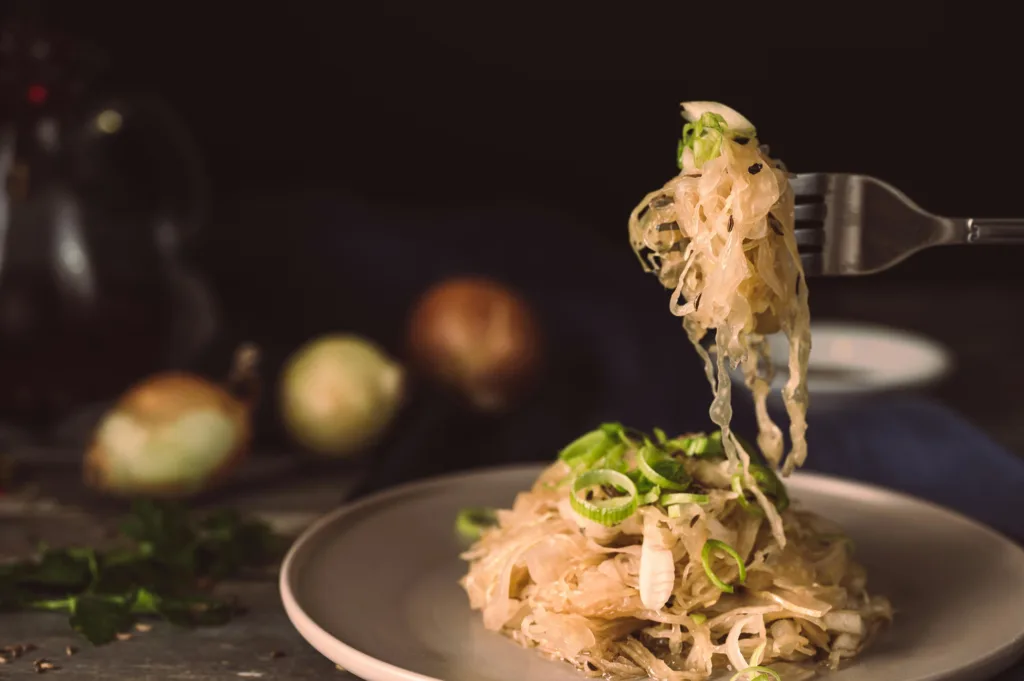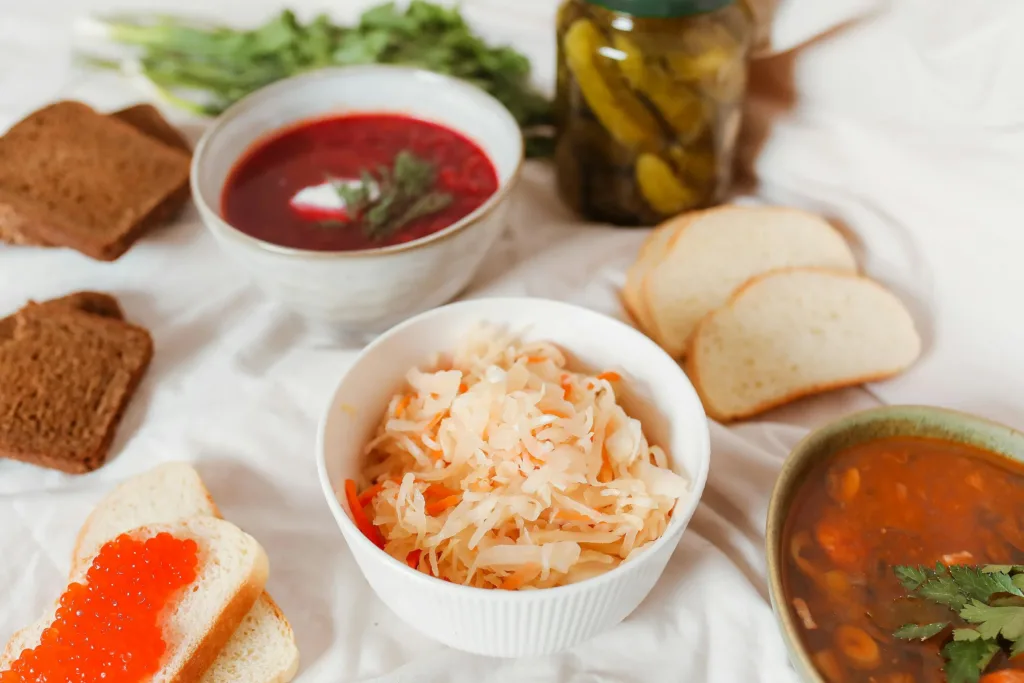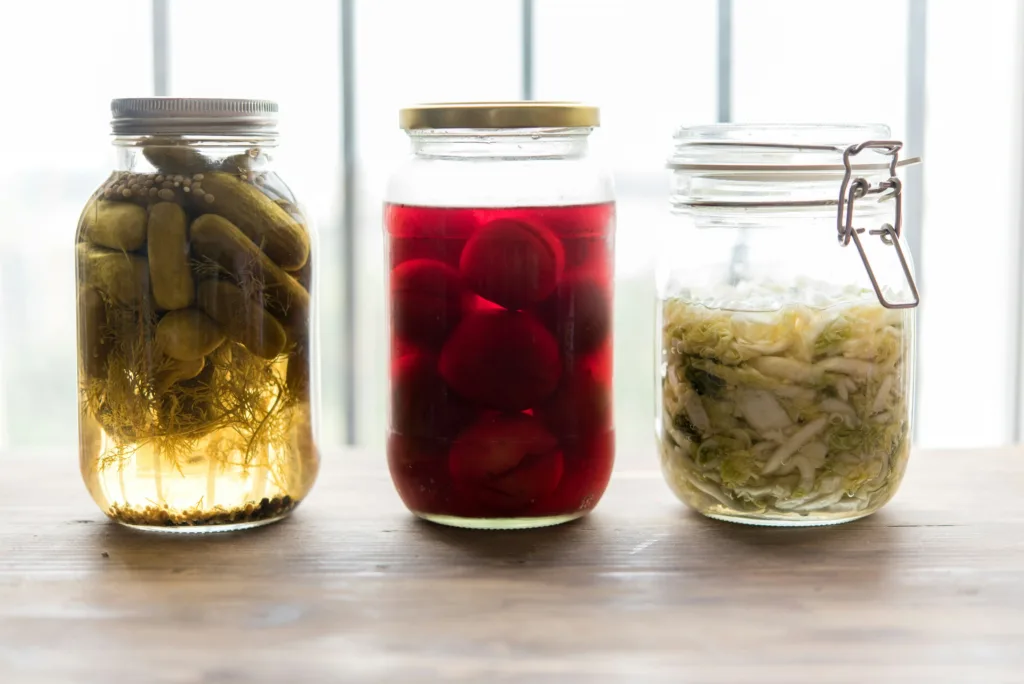Sauerkraut has been around for centuries, but it’s not just a nostalgic side dish for bratwurst or a topping for hot dogs. This fermented cabbage is a flavor powerhouse, adding tang, crunch, and brightness to anything it touches. Because it’s naturally sour and slightly salty, sauerkraut pairs beautifully with rich meats, creamy sauces, hearty grains, and even sweet ingredients. It can also bring an unexpected twist to familiar comfort foods.
Here’s a lineup of 10 sauerkraut recipes that prove just how versatile this ingredient can be. From weeknight-friendly dinners to dishes worth making for a crowd, you’ll find ideas here that work for all kinds of occasions.
This list of 10 sauerkraut dishes is easy enough to save in ReciMe, so you can keep all your favorites in one place, plan a week’s worth of meals, and have a smart grocery list ready in seconds. Whether you’re making a quick skillet dinner, a slow-cooked soup, or even a chocolate cake with a twist, you can store every step and ingredient in our app, tweak serving sizes, and pull it up on your phone when you’re ready to cook.


Why Sauerkraut is Worth Cooking With
Sure, sauerkraut is great next to a grilled sausage, but it can do way more than that. It’s crisp, tangy, and naturally packed with probiotics. That means it can brighten up soups, add bite to salads, or give casseroles some much-needed zing. Think of it like built-in seasoning – it cuts through heavy flavors, balances out creamy dishes, and adds a little depth to lighter meals. Plus, it’s affordable, keeps for ages, and can quietly turn “just okay” recipes into ones people ask you for.

1. German Sauerkraut
The basic recipe, and honestly, still one of the best. You only need cabbage, salt, and time. It ferments in its own brine, and after a couple of weeks you’ve got something crisp and tangy that works with just about anything.
Ingredients:
- 1 medium head white cabbage (about 1 kg), outer leaves removed
- 1 tablespoon salt (amount may vary based on cabbage weight and fermentation temperature)
- Bay leaves (optional)
- Caraway seeds (optional)
Preparing the sauerkraut
Start by ensuring all tools and containers are clean and dry. Remove the outer leaves from the cabbage, reserving one for later, and cut out the tough core. Shred the cabbage finely using a knife or mandoline. Weigh it to determine the correct amount of salt, then place both cabbage and salt into a large bowl. Massage the mixture firmly for 5 to 10 minutes until enough liquid is released to cover the cabbage when packed.
Transfer the cabbage and its brine into a clean jar, pressing down so it stays submerged. Add bay leaves or caraway seeds if desired. Place the reserved leaf on top to help hold the shreds down, then use a fermentation weight or a sealed bag filled with water to keep everything under the liquid. Cover the jar with a cloth or an airlock lid and ferment in a cool, dark place for 2 to 3 weeks, checking daily to release gas and keep the cabbage submerged. Once the desired tanginess is reached, seal the jar and store it in the refrigerator.
2. Cranberry Sauerkraut Meatballs
This slow-cooked dish combines the savory tang of sauerkraut with the sweetness of cranberry sauce and a mild heat from chili sauce. The flavors blend over several hours, resulting in tender meatballs coated in a thick, balanced sauce.
Ingredients:
- 1 can (14 oz) whole-berry cranberry sauce
- 1 can (14 oz) sauerkraut, rinsed and well drained
- 1 bottle (12 oz) chili sauce
- 3/4 cup packed brown sugar
- 1 package (32 oz) frozen fully cooked meatballs, thawed
- Minced chives (optional)
Cooking method
Combine cranberry sauce, sauerkraut, chili sauce, and brown sugar in a slow cooker, stirring to mix evenly. Add the meatballs and coat them with the sauce. Cover and cook on low for 4 to 5 hours, stirring occasionally if needed. The dish is ready when the meatballs are heated through and the flavors have melded. Sprinkle with minced chives before serving, if using.
3. Northwoods Wild Rice Salad
This salad is fresh but hearty, with chewy wild rice, tart sauerkraut, crisp veggies, and sweet apples. Toasted walnuts on top give it a nice crunch.
Ingredients:
- 2/3 cup uncooked wild rice
- 2 cans (14 oz each) sauerkraut, rinsed and well drained
- 1 medium apple, peeled and chopped
- 3/4 cup chopped celery
- 3/4 cup shredded carrot
- 1/2 cup finely chopped red onion
- 1/2 cup sugar
- 1/3 cup cider vinegar
- 3 tablespoons canola oil
- 1/4 teaspoon salt
- 1/4 teaspoon pepper
- 3 tablespoons minced fresh parsley
- 1 tablespoon minced fresh tarragon (or 1 teaspoon dried)
- 3/4 cup chopped walnuts, toasted
How it’s made
Cook the wild rice according to package instructions, then cool completely. In a large bowl, combine sauerkraut, apple, celery, carrot, onion, and cooled rice. In a separate bowl, whisk together sugar, vinegar, oil, salt, and pepper until sugar dissolves, then stir in parsley and tarragon. Pour the dressing over the sauerkraut mixture and toss well. Cover and refrigerate for at least 4 hours to allow flavors to blend. Stir in toasted walnuts just before serving.

4. Sauerkraut Latkes
These crispy potato pancakes are given an extra tang by adding sauerkraut to the batter. Apples are included to mellow the flavor, creating a balance between sweet and savory.
Ingredients:
- 3 pounds russet potatoes, peeled and shredded
- 1-1/2 cups shredded peeled apples
- 1-1/2 cups sauerkraut, rinsed and well drained
- 6 large eggs, lightly beaten
- 6 tablespoons all-purpose flour
- 2 teaspoons salt
- 1-1/2 teaspoons pepper
- 3/4 cup canola oil
- Optional: sour cream and chopped green onions
Making the latkes
In a large mixing bowl, combine shredded potatoes, apples, sauerkraut, and eggs. In a smaller bowl, mix flour, salt, and pepper, then stir into the potato mixture until evenly coated. Heat oil in a skillet over medium heat. Drop about 1/4 cup of batter per pancake into the hot oil, flattening slightly with a spatula. Fry in batches until golden brown on both sides, adding more oil as needed. Drain on paper towels and serve hot, with sour cream and green onions if desired.
5. Pork Chops with Sauerkraut
This slow-cooked dish combines seared pork chops with sauerkraut, brown sugar, and vegetables. The long, gentle cooking helps tenderize the meat and allows the flavors to develop fully.
Ingredients:
- 2 tablespoons canola oil
- 4 bone-in center-cut pork loin chops (8 oz each)
- 1 jar (32 oz) sauerkraut, undrained
- 3/4 cup packed brown sugar
- 1 medium green pepper, sliced
- 1 medium onion, sliced
Step-by-step preparation
Heat oil in a skillet over medium heat. Sear pork chops for 3 to 4 minutes on each side until browned. In a slow cooker, combine sauerkraut and brown sugar. Place pork chops on top, then add green pepper and onion. Cover and cook on low for 3 to 4 hours, until the pork reaches a safe internal temperature and is tender. Serve with a slotted spoon to drain excess liquid.
6. Kielbasa Casserole
This dish combines pasta, smoked Polish sausage, and a creamy mushroom-based sauce for a hearty meal. The pasta acts as the base, while sauerkraut adds a tangy note that balances the richness of the sausage and cheese. Swiss cheese melts into the sauce, giving a mild nutty flavor, and green onions provide a fresh touch. Dijon mustard and garlic bring extra depth without overpowering the main ingredients.
It is baked until the cheese on top turns golden and the filling is bubbling. The mixture of pasta, sausage, and sauce creates a filling meal that can be made ahead and baked when needed. The flavor improves slightly as it sits, making leftovers just as good the next day.
Ingredients:
- 4 cups uncooked penne pasta
- 1 1/2 pounds smoked Polish sausage or kielbasa, cut into 1/2-inch slices
- 2 cans (10 3/4 ounces each) condensed cream of mushroom soup, undiluted
- 1 jar (16 ounces) sauerkraut, rinsed and well drained
- 3 cups shredded Swiss cheese, divided
- 1 1/3 cups 2% milk
- 4 green onions, chopped
- 2 tablespoons Dijon mustard
- 4 garlic cloves, minced
Preparation process:
The pasta is cooked according to the package instructions, drained, and placed in a large bowl. Sliced sausage, mushroom soup, sauerkraut, 2 cups of cheese, milk, green onions, mustard, and garlic are stirred in until evenly combined. This mixture is transferred into two greased 8-inch square baking dishes, topped with the remaining cheese, and baked uncovered at 350°F for 45 to 50 minutes, until the top is golden and the filling is hot and bubbling.
7. Sausage and Sauerkraut
This is a one-skillet meal with potatoes, smoked sausage, sauerkraut, and onion. The potatoes absorb the smoky and tangy flavors as they cook, while the onion adds a mild sweetness to balance the sauerkraut’s sharpness. Black pepper rounds out the dish with a bit of heat.
The recipe is quick to prepare and can be cooked entirely in a single skillet, making it practical for busy days. The combination of textures from the tender potatoes and the bite of sauerkraut makes it a filling and simple dinner option.
Ingredients:
- 6 medium red potatoes, cubed
- 2 tablespoons canola oil
- 1 small onion, halved and sliced
- 1 pound smoked sausage, cut into 1/4-inch pieces
- 1 package (16 ounces) sauerkraut, rinsed and well drained
- 1/4 teaspoon pepper
Preparation process:
The potatoes are sautéed in oil over medium heat until lightly browned, then sliced onion is added and cooked until tender. Smoked sausage, sauerkraut, and pepper are stirred in, and the mixture is left to cook uncovered until everything is heated through, with occasional stirring to blend the flavors and prevent sticking.

8. Sausage Sauerkraut Soup
This slow-cooked soup combines sausage, sauerkraut, potatoes, carrots, and onion with a seasoned broth. The sauerkraut adds tang, brown sugar balances it with sweetness, and mustard and caraway seeds give a classic Central European flavor. The sausage infuses the broth as it simmers, making the soup rich and hearty.
It is prepared in a slow cooker, which allows the vegetables to become tender and the flavors to meld without much active cooking. The result is a warming soup that can be served on its own or with bread for a complete meal.
Ingredients:
- 6 small red potatoes, quartered
- 3 medium carrots, cut into 1/4-inch slices
- 1 medium onion, cut into thin wedges
- 1 can (14 ounces) sauerkraut, rinsed and well drained
- 1 tablespoon brown sugar
- 1 tablespoon spicy brown mustard
- 1 teaspoon caraway seeds
- 1 pound smoked kielbasa or Polish sausage, cut into 1-inch slices
- 2 cans (14 1/2 ounces each) reduced-sodium chicken broth
Preparation process:
The potatoes, carrots, and onion are placed in a slow cooker. In a separate bowl, sauerkraut is mixed with brown sugar, mustard, and caraway seeds, then layered over the vegetables. Sausage slices are added on top, followed by the broth. The soup is covered and cooked on low for 8 to 9 hours until the vegetables are tender and the flavors are fully developed, without stirring during cooking to keep the potatoes intact.
9. Sauerkraut Chocolate Cake
This is a chocolate layer cake with sauerkraut incorporated into the batter for moisture and texture. The sauerkraut, when finely chopped and drained, is not identifiable in flavor but helps keep the cake soft. The layers are frosted with a chocolate butter frosting.
The result is a rich dessert with a subtle tang and a texture similar to cakes that use coconut or shredded vegetables. It can be stored in the refrigerator for several days or frozen for longer keeping.
Ingredients:
- 1/2 cup butter, softened
- 1 1/2 cups sugar
- 3 large eggs, room temperature
- 1 teaspoon vanilla extract
- 2 cups all-purpose flour
- 1/2 cup baking cocoa
- 1 teaspoon baking powder
- 1 teaspoon baking soda
- 1/2 teaspoon salt
- 1 cup water
- 3/4 cup sauerkraut, drained, squeezed dry, and chopped
Frosting:
- 1 1/3 cups butter, softened
- 4 ounces unsweetened chocolate, melted
- 1 1/2 teaspoons vanilla extract
- 4 cups confectioners’ sugar
- 1/4 cup whole milk
Preparation process:
Butter and sugar are creamed together, then eggs are beaten in one at a time with vanilla. The dry ingredients are whisked together and added alternately with water, mixing until smooth. Chopped sauerkraut is stirred into the batter, which is poured into two greased and floured 8-inch round pans. The cakes are baked at 350°F for 35 to 40 minutes, cooled, then frosted with a mixture of butter, melted chocolate, vanilla, confectioners’ sugar, and milk, whipped until fluffy.
10. Sauerkraut Ham Balls
These are small fried appetizers made from ground ham, sauerkraut, cream cheese, and seasonings, coated in breadcrumbs. The sauerkraut gives a tangy note, while cream cheese binds the mixture and adds richness. The outside turns golden and crisp during frying.
They can be served warm with a dipping sauce or formed into larger portions for a main dish. Leftovers can be refrigerated or frozen, and they reheat well in the oven.
Ingredients:
- 1 pound ground fully cooked ham
- 1 jar (16 ounces) sauerkraut, drained and chopped
- 1/4 cup finely chopped onion
- 2 tablespoons plus 3/4 cup dry bread crumbs, divided
- 3 ounces cream cheese, softened
- 2 tablespoons minced fresh parsley
- 1 tablespoon prepared mustard
- 1/4 teaspoon garlic powder
- 1/8 teaspoon pepper
- 1/4 to 1/2 cup all-purpose flour
- 2 large eggs
- 1/4 cup whole milk
- Oil for deep-fat frying
Preparation process:
Ground ham, sauerkraut, onion, and 2 tablespoons of bread crumbs are mixed in one bowl, while cream cheese, parsley, mustard, garlic powder, and pepper are blended in another. The cream cheese mixture is combined with the ham mixture, then chilled for at least an hour. The chilled mixture is rolled into small balls, coated in flour, dipped in beaten eggs mixed with milk, and rolled in the remaining bread crumbs. The balls are fried in hot oil at 375°F until golden brown, then drained on paper towels before serving.

How to Store Sauerkraut
Fermented sauerkraut can last up to 3 months in the fridge if stored in a sealed container and submerged in its brine. Canned sauerkraut will keep for over a year unopened, but use it within a week once opened. Always transfer leftovers from cans into glass or plastic containers to keep the flavor fresh.
Conclusion
From traditional German-style ferments to inventive twists like chocolate cake, sauerkraut proves it can fit into almost any type of dish. The tangy crunch works just as well in a quick weeknight skillet as it does in a slow-simmered stew or a fresh salad. Having these 10 recipes in your back pocket means you can pull out a crowd-pleaser at a moment’s notice or try something completely new. Save them in ReciMe, keep the ingredient lists handy, and you’ll be ready to turn that jar of sauerkraut into something memorable any day of the week.
FAQ
What is the best way to prepare sauerkraut before cooking?
If you like a strong tang, you can use it straight from the jar. For a milder flavor, rinse and drain it before adding to your recipe.
Can I use homemade sauerkraut in these recipes?
Absolutely. Just make sure it’s fully fermented and has the flavor profile you like before mixing it in.
Does sauerkraut go bad once opened?
Yes, but it keeps for weeks in the fridge if stored in an airtight container and covered in its brine.
Are these recipes suitable for freezing?
Most cooked sauerkraut dishes freeze well, especially soups and casseroles. Fresh salads with sauerkraut are better enjoyed right away.
Can I replace sauerkraut with fresh cabbage?
You can, but it won’t have the same tang or depth of flavor. Fresh cabbage will also need a longer cooking time in most dishes.
